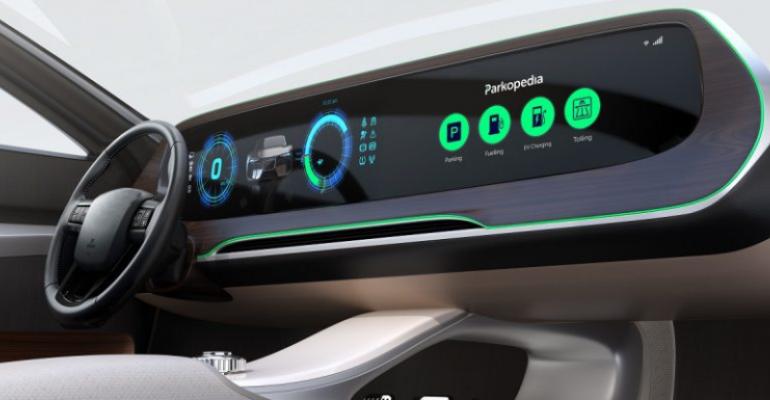While there are many significant trends at the moment, one of the key connected vehicle commerce trends to stand out is the monetization of vehicle data by automakers.
Sherry Calkins, vice-president of connected car and platform solutions at Geotab also sees a shift from vehicle ownership to share mobility and electrification. Citing McKinsey’s report Unlocking the full life-cycle value from connected-car data, she says the connected and autonomous vehicle (CAV) data monetization trends could add between $250Bn to $400Bn in annual incremental value. She adds: “Connectivity is an opportunity that OEMs cannot afford to ignore or be slow to endorse. For OEMs to capitalize on the opportunity, they must consider evolving their business models to support the connected-car ecosystem.”
With environmental sustainability in mind, she believes that data connectivity can help to optimize every aspect of a vehicle’s life cycle. This means that business models need to shift accordingly to re-focus on providing value beyond a single point of sale (POS). She argues that carmakers have a “built-in opportunity to develop the optimal connected car experience over a vehicle’s entire lifecycle”. This requires them to become seamlessly integrated into the global mobility ecosystem.
However, she warns that such integration can be challenging. Yet, it will be to the advantage of the automakers that manage to achieve it through the leveraging of the connected car ecosystem. Integration will involve the development of “symbiotic relationships with third-party vendors will be in a better position to adopt life-cycle monetization than those who remain in silos”.
Shared and electric mobility
Shared mobility is another growing trend within the automotive industry. Again, she claims that connected car data is a significant driver of any car-sharing operation. They can benefit from data insights because GPS can monitor a vehicle’s location and availability, and GPS zones can be established, too, to ensure that vehicles are operating in the right area. Telematics can also be deployed to ensure that the vehicles are being serviced, while keeping an eye on maintenance data, or on driver performance to improve vehicle safety and driving standards. She adds: “Connected vehicle data is vital to owning and operating an electric vehicle (EV). Data-driven solutions can help businesses take their fleet from zero to 100% electric.”
New monetization opportunities
In her opinion there are four trends that offer new opportunities for automakers to monetize the connected vehicle:
- With electrification, automakers can use connected vehicle data to better understand and cater to the needs of customers looking to switch to EVs and develop data-driven solutions;
- Automated payments to mirror smartphone applications that enable you to upload your bank information, speeding up online shopping checkouts and allowing for cardless payments in stores, or via road infrastructure such as road tolls. They can also enable cardless payments at the drive-thru, car wash or gas station. Automated payment solutions could provide insights into which driver is fueling up, when and where they are fueling up and how much it costs. She suggests this could help to optimize fuel usage and minimize fuel theft;
- Intelligent transportation networks designed to improve mobility, decrease congestion and improve road safety. To achieve these goals, data is required, creating opportunities for automakers with embedded solutions to provide anonymized and aggregated data to help transportation leaders develop data-driven solutions;
- Monetize predictive maintenance using real-time data to identify vehicle or truck failures before they occur. These insights, when leveraged effectively, can enable customers to avoid expensive repairs. For example, a data-driven predictive maintenance solution could signal to a driver when the vehicle requires maintenance, identify the closest service center, and pre-order the necessary parts, minimizing downtime of the assets and the driver.
Other commercial opportunities exist too, such as the provision of automotive infotainment and of e-commerce. In a recent press release, Grand View Research predicts that the global automotive infotainment market is expected to reach $15.13Bn by 2030, registering a CAGR of 9.3% during the forecast period 2022 to 2030. The company finds that there is increasing demand for advanced safety features, self-driving vehicles (or at the very least connected vehicles), digital cockpits for driver assistance, for information and entertainment as consumers are changing their preferences towards technologically advanced products. The spurs for this predication include the growth in the global e-commerce industry, an increase in automotive sales, and the digitalization of interfaces and channels.
Calkins adds: “Audio and navigation interfaces are starting to bolster eCommerce opportunities. For example, solutions like in-vehicle driver coaching. In the past, in-vehicle driver safety alerts would only beep or buzz or light up. Today, driver safety solutions like in-vehicle driver coaching deliver real-time spoken alerts to help drivers keep their eyes on the road and promote safe driving habits. Another way to look at it is through the lens of geotargeting. Geotargeting is a method of delivering different content to consumers based on their location and driving habits. For example, drivers could receive notifications identifying upcoming rest stops.”
Partnerships and data-sharing platforms
To maximize the opportunities for connected vehicle commerce, she says partnerships and data-sharing can permit two organizations with different data or different expertise to work together and innovate new solutions. Calkins concludes by arguing that the reality of connected vehicle commerce means that increased connectivity should lead to more stringent privacy and security.
To achieve this, she’d like to see a global data security and privacy standard developed and enforced. She believes that global measures, regarding data standards and data security, would enable better connectivity to help empower businesses to do better. This would at the very least inspire consumer confidence to spend more and to use connected vehicle commerce – including on streaming services, from Netflix to Spotify. The opportunities are wide-ranging. They don’t just exist within vehicles; the reality of connected vehicle commerce will involve the infrastructure around them as cars increasingly become a mobile commerce platform in their own right – much like our smartphones in our pockets are today.





